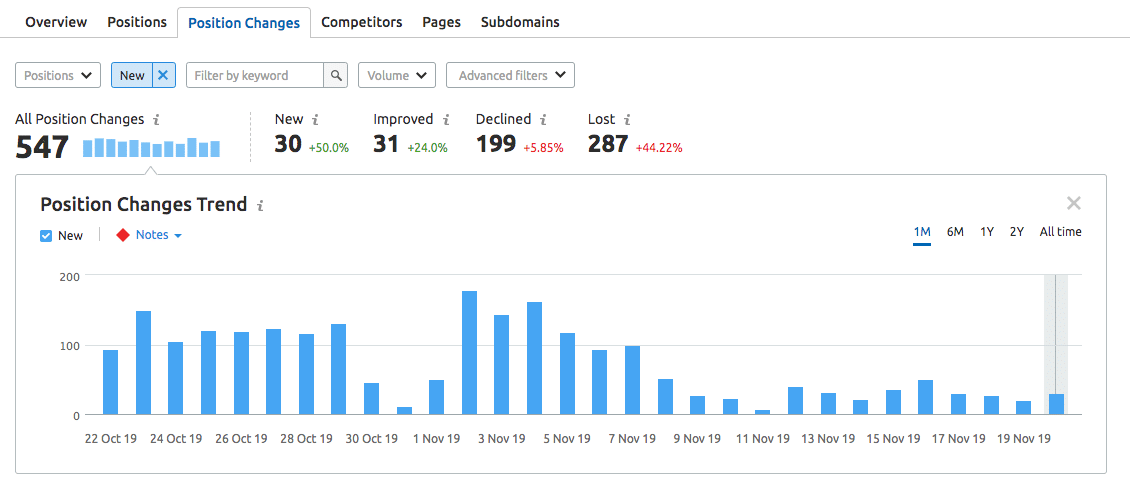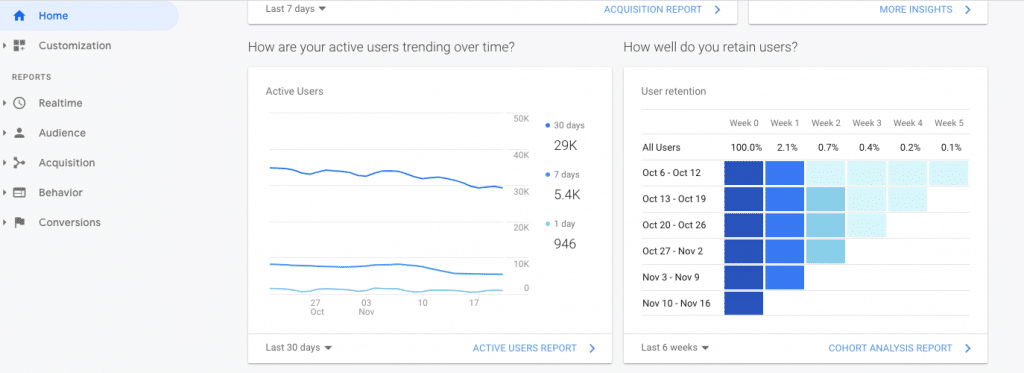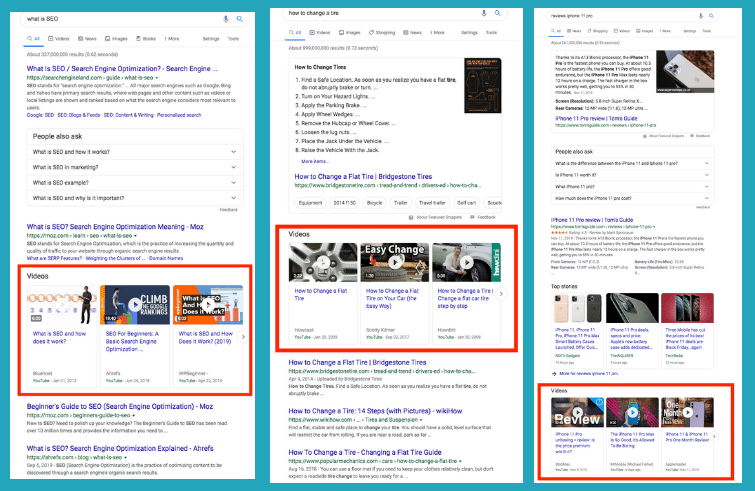Within your industry, every competitor wants to be the first search result that shows up when customers look for important terms. The way Google ranks these results can be mysterious, but search engine optimization (SEO) experts have figured out a few ways to improve google rankings. Google’s algorithm is always changing, so it’s important to stay up to date on the ways to improve your google rank in 2020.
12 Ways to Improve Your Google Rank in 2020
1. Choose a URL and Stick with It
Strictly speaking, domain age isn’t a major factor that Google will use to rank your website. On the other hand, changing your URL can definitely have an impact on how your site is performing.
When you change your URL, all existing links to your site may be broken, unless you create proper redirects. The links that go to your site (your backlinks) indicate to Google that other websites find your site reputable. More backlinks from other reputable sites (not spam links, or “toxic” links) generally correlate with higher google ranks. This means, if you want to improve your google rank in 2020, keep your URL structure the same. If you do have to reconfigure some of your URLS—perhaps you’re adding a blog area and you want to move some of your site content—make sure you add redirects.
A URL change also means that your site will have to be re-indexed or crawled by Google. This means you may lose your existing rank. If your pages don’t get high results to start with, a fresh start might be a good thing. However, if your pages perform fairly well in your industry, this might mean trouble.
Here are a few things to keep in mind when choosing your URL:
- Ideally, your URL should contain your keyword, though this might not always be possible.
- Your URL structure should be fairly simple and logical. If a user has to click on eight different pages to find a particular page, it’s too many.
- If you do change your domain or URL structure, always use redirects.
2. Check Your Current Search Ranking

SEMrush and similar tools can show you where you rank for particular search queries, and also how your rank changes over time.
Your Google rank might also be called your rank on a search engine results page (SERP). Where you rank will depend on what a user is looking for. If, for example, you provide landscaping services, you won’t show up for a search about dentists, and that’s good. Obviously, you don’t need to know your Google rank for every SERP. However, you should know which keywords are most important for your business, and you should know where your rank on those SERPs.
A number of SEO tools like SEMrush and Raven provide in-depth information about your keywords and Google rank. There are also free tools you can use to perform periodic checks. SERPs.com provides a free Keyword Rank Checker to test how well your site performs for different keywords, and in different locations. Once you know what keywords you need to target, how to incorporate them into your content, and where you stand, you can start on improving your Google Ranks in 2020.
3. Check your Site Speed

Google’s page-ranking methods are increasingly based on improving user experience. If your site loads fast and performs smoothly, users are more likely to stay on the page, return to it, and link it to others. Related to this, or perhaps because of this, Google tends to reward pages that load fast and place them higher on a SERP.
You can use any of the following tools to check page load times: GTmetrix, Pingdom, or Google PageSpeed Tools.
4. Start Using Google Analytics

Google Analytics might help you improve your Google rank more than any other tool. Best of all, it’s free.
If you’re working on your search engine optimization, you’ve probably set your site up with Google Analytics. If you haven’t yet, learn how to set it up and use it as soon as possible. With this tool, you can track conversions and sign-ups on your website, as well as keywords, traffic trends, your site’s speed, and many other factors. Since it is designed by Google for website managers, it’s one of the best ways to improve your Google website ranking in 2020.
Keep in mind that Google wants their users to have a good experience online. Pursuing this goal has helped them to become the top search engine in the world. This means Google prioritizes sites that give users good experiences and puts them higher in a SERP. Google interprets a good experience by low bounce rates, fast load times, long dwell times, and high click or conversion rates. All of these metrics indicate that users find your site useful—and all of these metrics are available on Google Analytics.
5. Use the Right Title Tags
It is ideal to place your most important keywords, as well as your brand name, in your page’s title tags.
Each page on your website should have a unique title tag. This shows Google that you really do have unique content on your website, and that your pages aren’t just duplicate content. This is also a great place to incorporate your keywords. To improve your Google ranking for a particular search, it’s a good idea to tell the search engine immediately what the page is about. This is what your title tag is for.
The SEO experts at Moz advise keeping your title under 60 characters, so it is fully displayed. They also provide this rule of thumb for title tags:
Primary Keyword – Secondary Keyword | Brand Name
This formula shouldn’t be the end-all solution for your title tags. On a SERP, that title tag is often the only thing read by the user. If your title tag isn’t drawing them in and letting you know about your company or the content of your page, it won’t do much for your website traffic.
Experiment with different well-performing keywords, locations or zipcodes. Remember that each page title should be unique, or your pages will start to compete with each other and the Google ranking of each will suffer.
6. Description Tags

This webpage description is brief, but straightforward and compelling.
Underneath your page title is your meta description. This information provides more details, both to Google’s bots and potential visitors, about your page content and purpose. As Google has changed their search algorithms over the years, description tags have slightly fallen in importance. In the past, these description tags could be filled with keywords and pop to the top of search engine result pages. Now serve the purpose of drawing users into your page.
Description tags should be written to give credibility to your company, to show what services or deals you offer, or to call the user to action on your page. It’s a good idea to use your keywords once in the description, but overdoing it may actually lower your rank. Meta descriptions are also shown when sharing your page on social media, so this is another reason to make it accurate, eye-catching, and brief.
7. Improve Site Architecture
Good site architecture means organizing all of your pages and information in the most logical way. As a simple guideline, it should take no more than three clicks to get to the deepest part of your site.
This helps you in two ways. If your site is overly confusing and causing users to click back to the search engine result page, your bounce rate increases and your user session time drops. If something is difficult to do on your website, your visitor will follow the path of least resistance and go somewhere else. Everything should be easy to find on your website.
A simple site architecture also means that Google will be able to crawl your pages more quickly.
An Example of Responsive Web Design in a Small Browser Window
8. Have a Mobile or Responsive Site
There are now more searches conducted on mobile devices than on laptops. Though this varies somewhat by industry, it has enormous implications for how your site ranks. In general, if your site isn’t mobile-friendly, it will lower your Google ranking. Mobile users will click away from your site faster if it doesn’t work or load properly on their devices, which will hurt your rank. Google algorithm is also programmed to look for load speed, so if your site isn’t loading on mobile devices, it will hurt your rank.
To help webmasters that haven’t yet created a mobile site or a responsive site (which rearranges content automatically for mobile users), Google provides mobile help documents to get started.
9. Create Informative Content
If Google didn’t provide accurate, trustworthy results, people would stop using the search engine. Recognizing this, Google created EAT to guide their SERPs, and to help content creators develop high-quality web pages. EAT stands for expertise, authority, and trustworthiness. This impacts several parts of your site, but the overall takeaway is that websites are known as industry authorities who also craft informative, trustworthy content that will improve Google rankings.
If you have a relatively new site, this might not be comforting news. However, there are ways you can still leverage EAT for your benefit. Here are a few things you can do:
- Use reliable links. Links to other sites (outbound links) show that you are using reliable sources for your site content.
- Credit an author. When writing informative content, such as blog posts, news items, or explanatory pages, show who wrote it and what their relevant experience is.
- Generate high-quality backlinks. When other sites link to yours, they’re giving your site a vote of confidence, which lends to your authority and trustworthiness. See where your content might be relevant or helpful to other sites, and contact the managers about a backlink.
- Disavow toxic links. Sometimes, spam sites will link to yours. These links can hurt your credibility and your Google ranking, but you can disavow backlinks to stop this.
10. Use Keywords Naturally
There was a time when keywords played a much larger role in how Google understood a user’s search queries and the results it generated in response. Now, Google uses artificial intelligence and a sophisticated neural network to understand language and generate results. Google does not simply create a SERP based on keyword matches. Thanks to a powerful Google Search update, BERT in November 2019, Google now understands users’ search intent better than ever before.
What does this mean for your website and your Google ranking? If you’re relying solely on keywords to improve your Google ranking, it won’t work. Keywords are important, but they also rely on context. Your content should be well-written, thorough, and clear. The practice of keyword stuffing—using a keyword and synonyms as much as possible to rise on a SERP—is now completely out of the question.
Long-Tail Keywords, BERT and Google
Essentially, BERT allows Google to better understanding “long-tail” keywords; search queries that are particularly long or specific. Though these types of queries get fewer searches than “broad” keywords—usually only one or two words long—long-tail keywords also show greater interest, and they tend to have fewer competing pages. This is good news for new websites. If you understand specific questions your potential customers or site visitors have in your industry, you can answer them directly and rise to the top of a small, but valuable search.
Larger sites won’t be as interested in long-tail niche keywords, since they won’t bring in much traffic. However, if your content is thorough and reliable—see the previous point—visitors will spend longer on the page, use it in links, and share it more often. Ultimately, this will improve the Google rank of your entire domain. If you continue to do this, you’ll start to see your overall domain authority increase, and you’ll be able to take on more competitive queries.
11. Use Video
You might have noticed in the last year or so that video results appear more often for more searches. Around 2017, the odds of seeing video results on a SERP increased by about 75%. These results, called “video carousels” since they display a number of video results in one place on the SERP, have continued to rise in frequency since then. Many unable to claim top spots on competitive searches have been able to rise to the top through video content.
There are a number of reasons for this. The first is an increase in diverse, multimedia results. Now knowing what type of results are best for you (unless you specify), Google provides text, pictures, lists, news articles, statistics, video, and more. This is an attempt to create a better user experience. The second reason may be Google’s effort to continue to grow YouTube, it’s video-hosting service, and ensure it remains the go-to video platform. Users watching YouTube videos also remain on a Google-owned internet property, instead of moving onto a different page. Finally, the increase in video carousels on SERPs may reflect users’ preferences; users are more likely to absorb more of a video and share more often.
Video results show up differently for different search queries. Some will appear very close to the top, others will not.
So what does this mean as far as improving your Google rank? Using video, both on YouTube and embedded on your page, can bring in more traffic from multiple directions. A well-crafted video can encourage more shares and longer dwell time, while also winning a top spot in a video carousel. However, video results do not appear equally across all searches. Research your industry and search queries first to be sure video makes sense for your page.
12. Aim for SERP Spot Zero

A Featured Snippet position is very valuable. Not all searches have a featured snippet, others might even have two, like this one.
Video carousels are not the only recent change to come to the SERP. You may have noticed that many of your search queries are already answered by Google before you visit any page at all. You might see short lists, paragraphs, or tables at the top of the search in a box, which Google calls a Featured Snippet. This information is extracted from somewhere in the SERP, usually (but not always) from the first or second result. SEO experts consider this “SERP spot zero” since it appears before even the number one result. Results in SERP spot zero get more clicks than the top spot, which means earning this spot can improve your Google rank dramatically.
How Can You Get a Featured Snippet?
While there’s no special code or formula that will automatically win you this spot, you can alter your web page content slightly to get the best chances of appearing there. Here are a few tips to snatch this spot:
- If you are describing a process, use a numbered format and brief sentences. Place this near the top of the page.
- When creating a list, use bullets, also near the top of the page.
- If you are answering a question, include the question and the answer in full, but briefly, at the top of the page.
- Keep in mind that featured snippets are most popular for question queries that begin with or contain “who, what, when, where, why, how”
- Nearly all featured snippets are derived from results already appearing on the first SERP, so your overall page and content must also be up-to-par.
Improving your Google rank can help you generate more traffic, which means more website visitors and, ultimately, customers. For your traffic to truly convert customers, you must also have a digital marketing strategy made to introduce web visitors to your product or service. With all of these parts in place, you can truly make Google work for you, whether you have a small, new site or a long-standing, large site.


